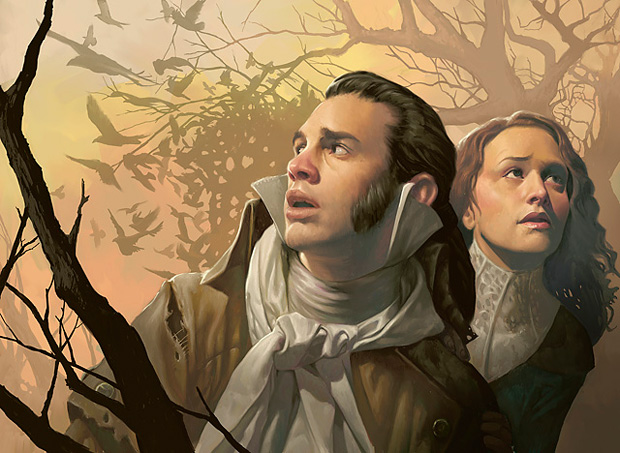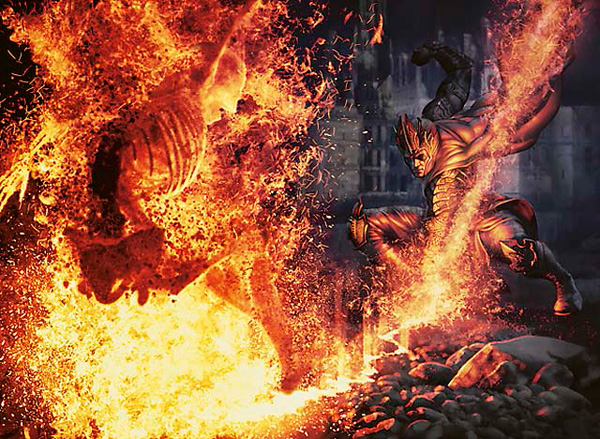
[Wizards of the Coast safe]
Every choice we make in designing a set influences how it will play, but some of them make larger impacts than others. Foremost among them are the choices we make surrounding what I’ll call ‘marquee mechanics,’ that is, ones that dictate the shapes of the environments they appear in. Prime examples include Landfall in Zendikar and Infect in Scars of Mirrodin.
Every choice we make in designing a set influences how it will play, but some of them make larger impacts than others. Foremost among them are the choices we make surrounding what I’ll call ‘marquee mechanics,’ that is, ones that dictate the shapes of the environments they appear in. Prime examples include Landfall in Zendikar and Infect in Scars of Mirrodin.
Now you probably already have a question: why do
we want marquee mechanics in the first place? Every set needs to serve as a
change of pace to keep highly invested players engaged, and that means that we
as designers need to keep moving our spotlight. In order to do that we need to have
one, and marquee mechanics serve as focal points for both designers and players.
They not only show us where to look for interactions to build a novel
environment, the mechanics also give players a handhold to guide them through
the new landscape. Alright, so what are our constraints?
Theme Party
Whether we start top-down or bottom-up, every fifth-age set eventually converges upon a theme that we want to evoke. The experiences that compose a game of Magic invariably elicit emotional responses from the players, so since a marquee mechanic so heavily influences the play patterns in its environment, it’s essential to ensure that it’s leading to player experiences that mesh with the theme.
Feeling of Dread by John Stanko
For instance, Theros had a theme of accomplishment. Heroic triggers require effort on their controller’s part to let creatures overcome obstacles (blockers) that they couldn’t before. This pattern gives players a taste of the theme with each trigger, whereas triggering Landfall feels trivially easy and the rewards are usually temporary; no accomplishment there.
Lookin' Good
But when we get right down to it, everything in a set ought to
in some way support its theme. What differentiates a mechanic which could carry
a set from one that merely fits into it? As I mentioned at the start of this
post, a marquee mechanic not just serves its role, but shows the players what's going on.
Explosive Impact by Steve Argyle
A mechanic like Scry can do its work perfectly well from the background, but it’s never going to stand out to the player base as the defining feature that sets a particular environment apart. In order to show the players what they should focus on, a marquee mechanic needs to look like a central piece of the environment in addition to being one. That means direct involvement with pivotal plays like turning up a Morph to win combat or sacrificing a bunch of Eldrazi Spawn to cast something enormous.
It's Never Simple
That sort of impact can't just be occasional either. In order to achieve the as-fan needed to define its limited environment, a marquee mechanic is going to have to show up at common, and that, in turn, means that it will have to adhere to New World Order. It will set off red flags if the mechanic is particularly texty, hard to parse, or affects other permanents on the battlefield.
Bureaucracy by Mark Zug
That said, the constraints on such a mechanic are actually somewhat less stringent than those on your average common. A set can only manage so much complexity, but spending more ‘points’ on a widespread mechanic gets us more bang for our metaphorical buck. Once a player has gone to the trouble of figuring out one card with the mechanic, they’re most of the way to figuring out the rest. That’s why the likes of Bestow and Morph have gotten a pass to appear on commons, whereas something like Tavern Swindler (that’s simpler in a vacuum) hasn’t got a chance.
Fun in the Sun
But no matter how well a mechanic lines up with the other
factors in its eligibility to carry a set, if it isn’t fun, it isn’t on the
table. It doesn’t matter if it hits your theme dead on and players understand the effect right away if they aren’t going to enjoy playing with it. That
sounds obvious, but it’s all too easy to get so tied up in the competing
constraints of a design that fitting feels the same as belonging. Take a step
back and playtest the mechanic from both sides. Because you really don’t want
to build a set around Landhome.




Excellent article, Jules. This relates strongly to a topic I've been increasingly considering in my designs, which is the cultivation of emotional experiences - writing for 'mood', in other words - in Magic sets.
ReplyDeleteYou touch briefly upon the importance of marquee mechanics in establishing the player experience, and that's really nice. I'd argue that every single marquee mechanic since, hm, NWO roughly, has been establishing a player experience. (Yes, even landfall, despite your comments against it. ;D) I've been especially considering this in my own independent experiments with Tesla, so when I write the article, I'll probably frame it against the Tesla development so far.
I've been wanting to write an article about this - especially since it's a bit lengthy to go into for a comment - so, suffice to say, thanks for the smart and illuminating summary of marquee mechanics. This is one of those summaries that is so well-made that it actually teaches you a bit more about the subject than when you went in. (:
Thanks! I look forward to reading your thoughts on the matter once you post them.
DeleteAs for the rest I just have one clarification: I don't dislike Landfall. In fact, I think it's one of the best mechanics in Magic history. I was just using it as an example of what could happen if a marquee mechanic doesn't match a theme. Landfall is great at making the draw step feel good, adding back and forth to the game, pushing it towards a conclusion, and smoothing out draws. It is not, however, good at letting players feel like they've accomplished something. That's not a problem, it just means that Landfall didn't belong on center stage in Theros.
Zendikar was about surviving a living landscape, right, so trying to resist your opponent's land-fueled onslaught was thematic in that way.
DeleteI understand Jules, I was just teasing you. (:
DeleteLandfall was actually one of the best mechanics in Zendikar, in my opinion, as it served a lot of purposes at once, including Jay's note.
I agree that Landfall isn't the best 'accomplishment'. It's very good, however, at making people feel momentarily triumphant, but then immediately wanting more. It engenders in its players a sense of wanderlust.